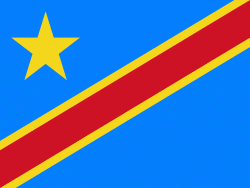Mai-Ndombe (Mai Ndombe)
Mai-Ndombe is one of the 21 new provinces of the Democratic Republic of the Congo created in the 2015 repartitioning. Mai-Ndombe, Kwango, and Kwilu provinces are the result of the dismemberment of the former Bandundu province. Mai-Ndombe was formed from the Plateaux and Mai-Ndombe districts. The town of Inongo was elevated to capital city of the new province.
Mai-Ndombe Province was a separate province from 1962 to 1966, prior the creation of Bandundu Province from the post-colonial political regions of Kwango, Kwilu, and Mai-Ndombe. Presidents (from 1965, governors) were: A whaling vessel sank in the province in 2021, killing at least 60 people.
* 8 Sep 1962 - Dec 1963 Victor Kumoriko
* 23 Sep 1963 - 11 Oct 1963 V. Bola (in rebellion)
* Jan 1964 - Dec 1964 Gabriël Zangabie
* 1964 - 1965 ...
* 27 Jul 1965 - 25 Apr 1966 Daniël Mongiya
Mai-Ndombe Province was a separate province from 1962 to 1966, prior the creation of Bandundu Province from the post-colonial political regions of Kwango, Kwilu, and Mai-Ndombe. Presidents (from 1965, governors) were: A whaling vessel sank in the province in 2021, killing at least 60 people.
* 8 Sep 1962 - Dec 1963 Victor Kumoriko
* 23 Sep 1963 - 11 Oct 1963 V. Bola (in rebellion)
* Jan 1964 - Dec 1964 Gabriël Zangabie
* 1964 - 1965 ...
* 27 Jul 1965 - 25 Apr 1966 Daniël Mongiya
Map - Mai-Ndombe (Mai Ndombe)
Map
Country - Democratic_Republic_of_the_Congo
 |
 |
| Flag of the Democratic Republic of the Congo | |
Centered on the Congo Basin, the territory of the DRC was first inhabited by Central African foragers around 90,000 years ago and was reached by the Bantu expansion about 3,000 years ago. In the west, the Kingdom of Kongo ruled around the mouth of the Congo River from the 14th to 19th centuries. In the northeast, center and east, the kingdoms of Azande, Luba, and Lunda ruled from the 16th and 17th centuries to the 19th century. King Leopold II of Belgium formally acquired rights to the Congo territory in 1885 and declared the land his private property, naming it the Congo Free State. From 1885 to 1908, his colonial military forced the local population to produce rubber and committed widespread atrocities. In 1908, Leopold ceded the territory, which thus became a Belgian colony.
Currency / Language
| ISO | Currency | Symbol | Significant figures |
|---|---|---|---|
| CDF | Congolese franc | Fr | 2 |
| ISO | Language |
|---|---|
| FR | French language |
| KG | Kongo language |
| LN | Lingala language |















